cooling PONTIAC GRAND AM 1998 Owners Manual
[x] Cancel search | Manufacturer: PONTIAC, Model Year: 1998, Model line: GRAND AM, Model: PONTIAC GRAND AM 1998Pages: 370, PDF Size: 16.11 MB
Page 72 of 370
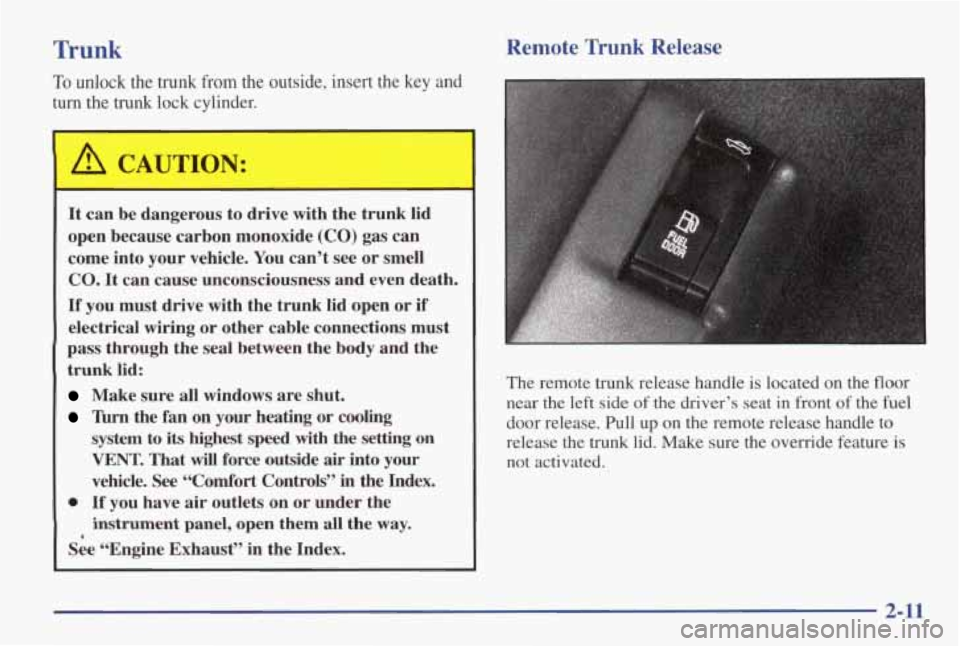
Trunk Remote Trunk Release
To unlock the trunk from the outside, insert the key and
turn the trunk lock cylinder.
1 A CAUTION:
It can be dangerous to drive with the trunk lid
open because carbon monoxide
(CO) gas can
come into your vehicle.
You can’t see or smell
CO. It can cause unconsciousness and even death.
If you must drive with the trunk lid open or if
electrical wiring or other cable connections must
pass through the seal between the body and the
trunk lid:
Make sure all windows are shut.
lbrn the fan on your heating or cooling
system
to its highest speed with the setting on
VENT. That will force outside air into your
vehicle. See “Comfort Controls” in the Index.
instrument panel, open them all the way.
0 If you have air outlets on or under the
See “Engine Exhaust” in the Index.
a
The remote trunk release handle is located on the floor
near the
left side of the driver’s seat in front of the fuel
door release. Pull up on the remote release handle
to
release the trunk lid. Make sure the override feature is
not activated.
2-11
Page 133 of 370
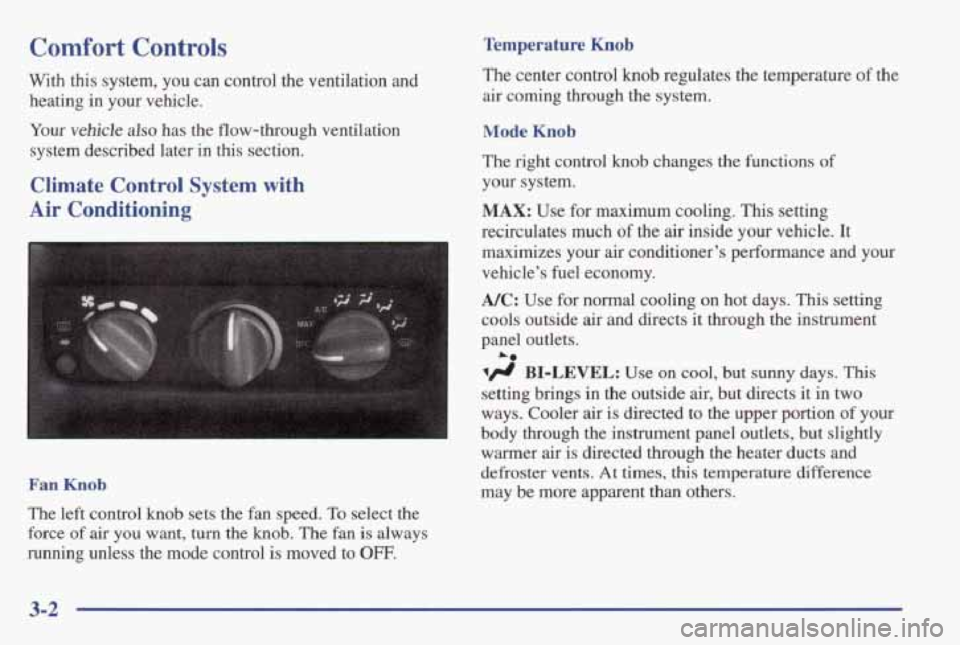
Comfort Controls Temperature Knob
With this system, you can control the ventilation and heating
in your vehicle. The
center control knob regulates the temperature of the
air coming through
the system.
Your
vehicle also has the flow-through ventilation Mode Knob
system described later in this section.
Climate Control System with your system.
Air Conditioning MAX: Use for maximum cooling. This setting
The right control knob changes
the functions
of
recirculates much of the air inside your vehicle. It
maximizes your air conditioner’s performance and your
vehicle’s fuel economy.
A/C: Use for normal cooling on hot days. This setting
cools outside
air and directs it through the instrument
panel outlets.
A0
BI-LEVEL: Use on cool, but sunny days. This
setting brings in the outside air, but directs it in two
ways. Cooler
air is directed to the upper portion of your
body through the instrument panel outlets, but slightly
Fan Knob
The left control knob sets the fan speed. To select the
force
of air you want, turn the knob. The fan is always
running unless the mode control
is moved to OFF.
warher airis directed through the heater ducts and
defroster vents. At times,
this temperature difference
may be more apparent than others.
3-2
Page 134 of 370
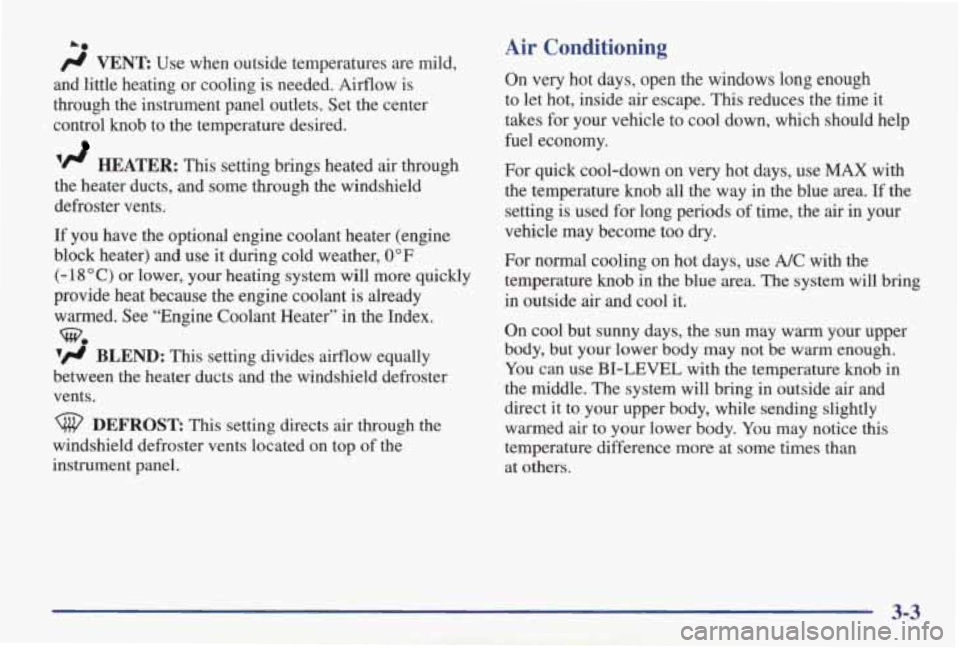
Am
/J VENT: Use when outside temperatures are mild,
and little heating or cooling
is needed. Airflow is
through the instrument panel outlets. Set the center
control knob to the temperature desired.
‘fl HEATER: This setting brings heated air through
the heater ducts, and some through the windshield
defroster vents.
If you have the optional engine coolant heater (engine
block heater) and use it during cold weather, 0°F
(- 18 O C) or lower, your heating system will more quickly
provide heat because the engine coolant is already
warmed. See “Engine Coolant Heater” in the Index.
v# BLEND: This setting divides airflow equally
between the heater ducts and the windshield defroster vents.
w.
DEFROST This setting directs air through the
windshield defroster vents located on top of the
instrument panel.
Air Conditioning
On very hot days, open the windows long enough
to let hot, inside air escape. This reduces the time it
takes for your vehicle to cool down, which should help
fuel economy.
For quick cool-down on very hot days, use
MAX with
the temperature knob all the way in the blue area.
If the
setting is used for long periods of time, the air in your
vehicle may become too dry.
For normal cooling on hot days, use
A/C with the
temperature knob in the blue area. The system will bring
in outside air and cool it.
On cool but sunny days, the sun may warm your upper
body,
but your lower body may not be warm enough.
You can use BI-LEVEL with the temperature knob in
the middle. The system will bring in outside air and
direct it to your upper body, while sending slightly warmed air to your lower body. You may notice this
temperature difference more at some times than
at others.
3-3
Page 137 of 370

Ventilation System
Use when outside temperatures are mild, and little heating or cooling is needed.
Turn the right knob to
VENT. Airflow is directed through the instrument panel
outlets. Set the center
knob to the temperature desired.
Your vehicle’s flow-through ventilation system supplies
outside
air into the vehicle when it is moving. Outside
air will also enter the vehicle when the heater or the air
conditioning fan is running.
Adjust the direction
of
airflow by moving the
Ventilation Tips
0
0
0
Keep the hood and front air inlet free of ice, snow or
any other obstruction (such as leaves). The heater
and defroster will work far better, reducing the
chance
of fogging the inside of your windows.
When
you enter a vehicle in cold weather, turn the
fan control knob to the highest position for
a few
moments before driving
off. This helps clear the
intake ducts
of snow and moisture, and reduces the
chance of fogging the inside of your windows.
Keep the air path under the front seats clear of
objects. This helps air to circulate throughout
your vehicle.
3-6
Page 182 of 370
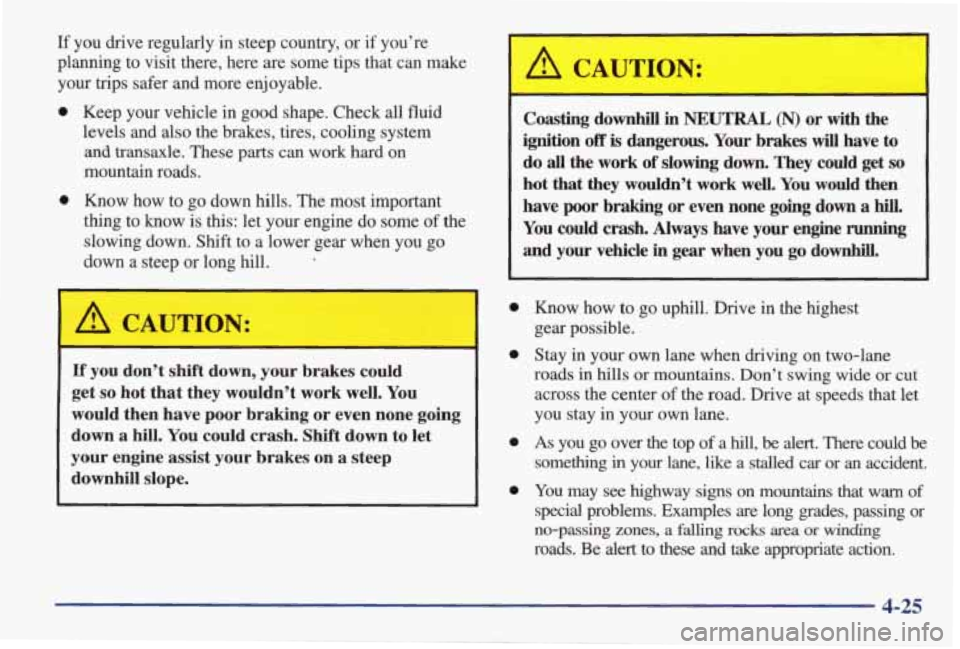
If you drive regularly in steep country, or if you’re
planning to visit there, here are some tips that can make
your trips safer and more enjoyable.
e
e
Keep your vehicle in good shape. Check all fluid
levels and
also the brakes, tires, cooling system
and transaxle. These parts can work hard on
mountain roads.
Know how to go down hills. The most important
thing to know is this: let your engine do some
of the
slowing down.
Shift to a lower gear when you go
down a steep or long hill.
-A CAUTION:
If you don’t shift down, your brakes could
get
so hot that they wouldn’t work well. You
would then have poor braking or even none going
down a
hill. You could crash. Shift down to let
your engine assist your brakes on a steep
~ downhill slope.
A CAUTION:
e
Coasting downhill in NEUTRAL (N) or with the
ignition
off is dangerous. Your brakes will have to
do all the work of slowing down. They could get so
hot that they wouldn’t work well. You would then
have poor braking or even none going down a hill.
You could crash. Always have your engine running
and your vehicle in gear when you go downhill.
e
0
0
0
Know how to go uphill. Drive in the highest
gear possible.
Stay
in your own lane when driving on two-lane
roads in hills
or mountains. Don’t swing wide or cut
across the center of the road. Drive at speeds that let
you stay in your own lane.
As you go over the top of a hill, be alert. There could be
something in your lane, like a stalled car or an accident.
You may
see highway signs on mountains that warn of
special problems. Examples are long grades, passing or
no-passing zones, a falling rocks area or winding
roads. Be alert to these and take appropriate action.
4-25
Page 199 of 370
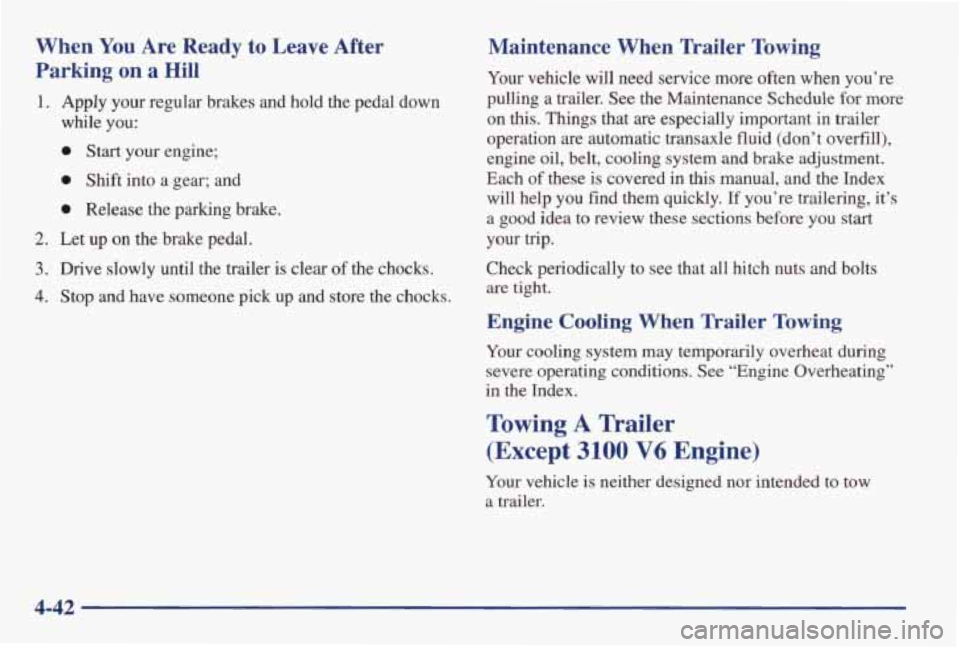
When You Are Ready to Leave After
Parking on a Hill
1. Apply your regular brakes and hold the pedal down
while you:
0 Start your engine;
0 Shift into a gear; and
0 Release the parking brake.
2. Let up on the brake pedal.
3. Drive slowly until the trailer is clear of the chocks.
4. Stop and have someone pick up and store the chocks.
Maintenance When Trailer Towing
Your vehicle will need service more often when you’re
pulling a trailer. See the Maintenance Schedule
for more
on this. Things that are especially important in trailer
operation are automatic transaxle fluid (don’t overfill),
engine oil, belt, cooling system and brake adjustment.
Each
of these is covered in this manual, and the Index
will help you find them quickly. If you’re trailering, it’s
a good idea to review these sections before you
start
your trip.
Check periodically to see that all hitch nuts and bolts
are tight.
Engine Cooling When mailer Towing
Your cooling system may temporarily overheat during
severe operating conditions.
See “Engine Overheating’’
in the Index.
Towing A Trailer
(Except
3100 V6 Engine)
Your vehicle is neither designed nor intended to tow
a trailer.
4-42
Page 215 of 370

Cooling System
When you decide it’s safe to lift the hood, here’s what
you
’11 see:
2.4L Engine
3100 Engine
A. Coolant Surge Tank with Pressure Cap
B. Electric Engine Cooling Fan
5-16
Page 216 of 370
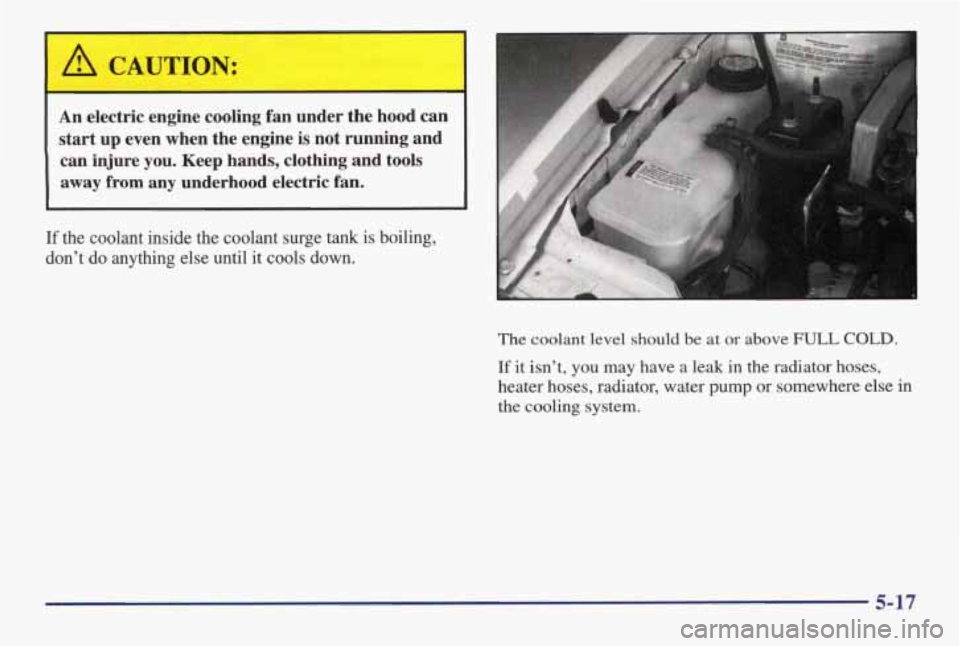
A CAUTION:
An electric engine cooling fan under the hood can
start up even when the engine is not running and
can injure you.
Keep hands, clothing and tools
away from any underhood electric
fan.
If the coolant inside the coolant surge tank is boiling,
don’t
do anything else until it cools down.
I
The coolant level should be at or above FULL COLD.
If it isn’t, you may have a leak in the radiator hoses,
heater hoses, radiator, water pump or somewhere else in
the cooling system.
5-17
Page 217 of 370
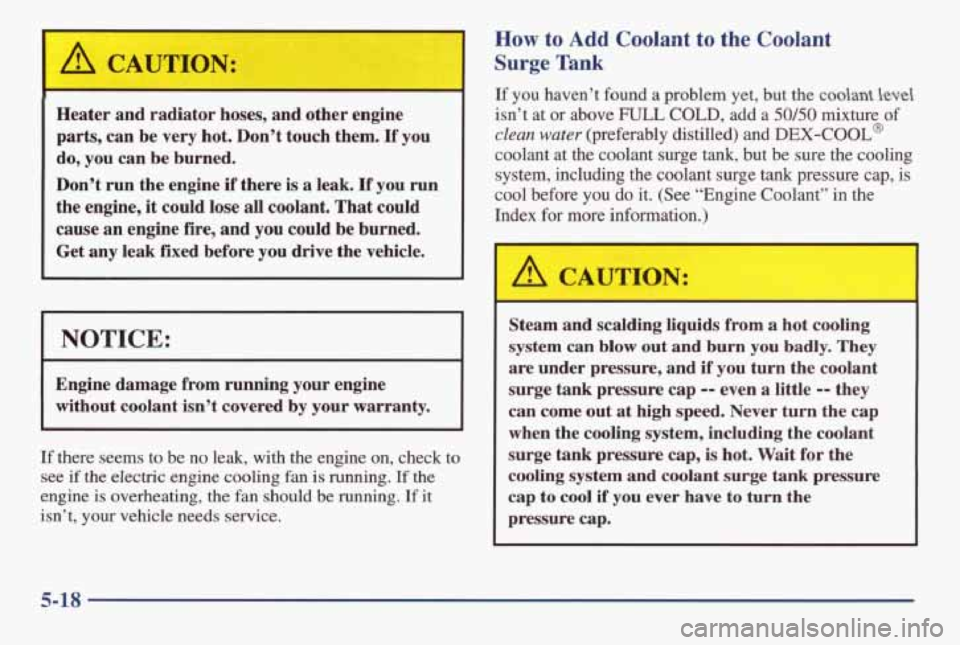
LA CAUTION: I
-1 -
Heater and radiator hoses, and other engine
parts, can be very hot. Don’t touch them.
If you
do, you can be burned.
Don’t run the engine
if there is a leak. If you run
the
engine, it could lose all coolant. That could
cause an engine
fire, and you could be burned.
Get
any leak fixed before you drive the vehicle.
NOTICE:
Engine damage from running your engine
without coolant isn’t covered
by your warranty.
If there seems to be no leak, with the engine on, check to
see if the electric engine cooling fan is running. If the
engine is overheating, the fan should be running. If it
isn’t, your vehicle needs service.
How to Add Coolant to the Coolant
Surge Tank
If you haven’t found a problem yet, but the coolant level
isn’t at or above FULL COLD, add a 50/50 mixture of
clean water (preferably distilled) and DEX-COOL@
coolant at the coolant surge tank, but be sure the cooling
system, including the coolant surge
tank pressure cap, is
cool before you do it. (See “Engine Coolant” in the
Index for more information.)
’ /$ CAUTION:
-
Steam and scalding liquids from a hot cooling
system
can blow out and burn you badly. They
are under pressure, and if you turn the coolant
surge
tank pressure cap -- even a little -- they
can come out
at high speed. Never turn the cap
when the cooling system, including the coolant
surge
tank pressure cap, is hot. Wait for the
cooling system and coolant surge
tank pressure
cap to cool if you ever have to turn the
pressure cap.
5-18
Page 218 of 370
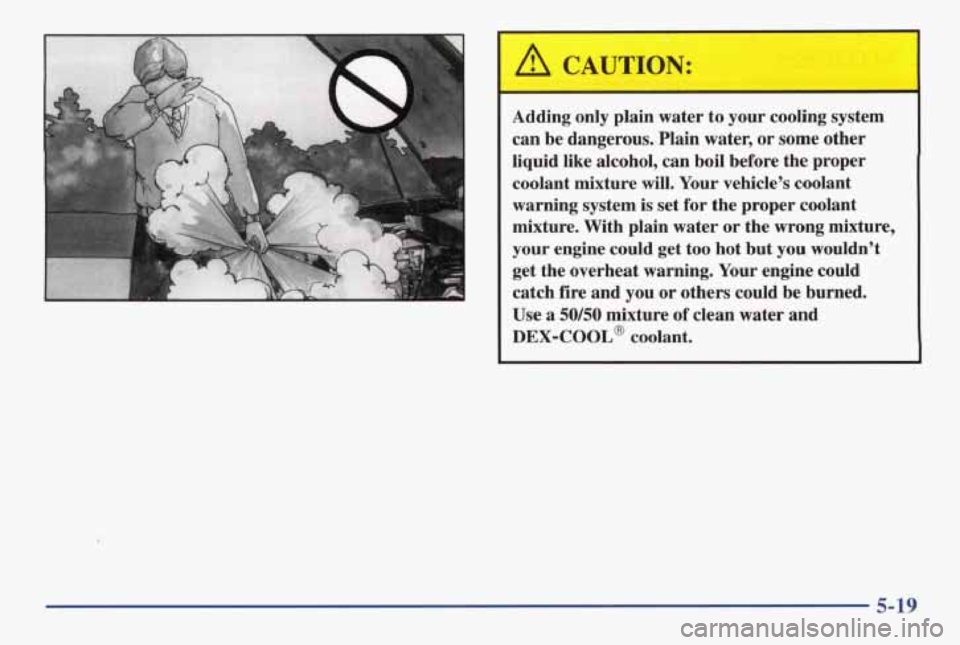
b. - A CAUTION:
I -
Adding only plain water to your cooling system
can be dangerous. Plain water, or some other
liquid like alcohol, can boil before the proper coolant mixture will. Your vehicle’s coolant
warning system
is set for the proper coolant
mixture. With plain water or the wrong mixture,
your engine could get too hot but you wouldn’t
get the overheat warning. Your engine could
catch
fire and you or others could be burned.
Use a
50/50 mixture of clean water and
DEX-COOL@ coolant.
5-19